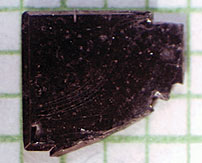- Number 294 |
- August 31, 2009
Understanding and controlling iron superconductors

FeAs Crystal
Superconductors carry electricity with nearly perfect efficiency and have many actual and potential uses in making the electrical grid more efficient and more reliable as well as in medical equipment relying on high magnetic fields such as MRIs. Unfortunately currently available superconductors are difficult (and expensive) to make and use.
In 2008, an entirely new class of high temperature superconductors based on iron was reported by a Japanese group, igniting a worldwide explosion of research aimed at understanding these materials and finding new potentially useful compositions. A combined effort between DOE’s Ames Laboratory and Oak Ridge National Laboratory has firmly placed the United States at the forefront of understanding and controlling these materials.
Ames Laboratory researchers, led by senior physicist Paul Canfield, have pioneered the growth of single crystals, discovered new, simpler, and safer methods of making these materials superconducting, and, by replacing Fe with other transition metals, have revealed a remarkably universal phase diagram.
Neutron scattering measurements of the magnet and atomic structures as well as excitations from both the High Flux Isotope Reactor and the Spallation Neutron Source at Oak Ridge, in combination with first principles theory, have ruled out the standard mechanism of low temperature superconductivity revealing instead a theoretical picture involving magnetic fluctuations.
Of equal importance, a key technological parameter, the upper critical field has been found to be both remarkably high and essentially isotropic, giving rise to the hope that the iron-arsenide (FeAs) superconductors may become cheaper and easier to use industrial materials. To date, more than 100 papers have been published by the collaborating research groups over the 18-month span since the initial discovery.Submitted by DOE's Ames Laboratory
